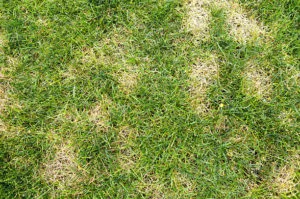In last month’s blog from Lane’s Landscaping Supplies, the topic focused on winter’s impact on your topsoil.
Although winter’s just about over (the official first day of spring is Tuesday, March 20), there’s still a chill in the air, and the possibility of one last snowfall too.
Now, we know you can put down mulch in March.
However, if Old Man Winter really is gone for the year, should you learn how to revive dead grass fast and then calculate how much topsoil you need and apply a brand new layer?
Or should you wait until it’s warmer and drier to do so?
 Take a look at the soil underneath your lawn
Take a look at the soil underneath your lawn
Without strong topsoil, your grass simply can’t grow.
Ever wonder why does grass turn yellow in winter or why you end up with a brown lawn? That’s a big reason.
So when you can, head outside and inspect the soil. If it looks to be in bad shape or eroding with things like…
- Discolouration (healthy topsoil is a dark brown or black; dirt is lighter in colour)
- Looseness (good topsoil breaks apart easy; poor topsoil is clumpy and sticks together)
- High or low pH levels (get a testing kit; topsoil should fall within a pH range of 5.5-7.0)
…then it probably is.
If the soil is workable – and the weather is cooperative – here’s what you can do to revive dead grass fast:
- Aerate the lawn
- Apply new soil for topdressing
- Overseed your lawn
- Mow (with your blades 3” high
- Fertilize
- Check for weeds and insects
Should your topsoil be frozen or soggy, then your best bet is to wait a few more weeks.
 Topsoil in your garden
Topsoil in your garden
Before applying fresh topsoil to your garden, the first thing you should do is check the weather report.
You want to make certain the threat of frost is truly gone and any flowers or bulbs you want to plant can thrive in Mississauga’s “hardiness zone.”
- According to the Canadian government’s plant hardiness site, Mississauga is in zone 6b with a hardiness index of 66.
- That means, across Canada, this area is the 6th warmest (the hardiness scale goes from 0-8, with 0 being the coldest and 8 being the warmest).
- Plants in this zone can tolerate temperatures as low as -23°C.
Afterwards, grab a shovel and try to dig up a bunch of soil.
If you can’t (because the soil is too hard), then you shouldn’t spread fresh topsoil products because you won’t be able to till it properly.
On the other hand, if the soil crumbles in the shovel, then you can start putting down new soil.
Spring precipitation and how to revive dead grass fast
Spring can be a funny season.
Some years, it rains consistently, while in other years, hardly a drop falls.
According to the Old Farmer’s Almanac, the last snowfall of winter is expected to occur in mid-March (which makes it pretty much impossible to put down topsoil).
Moving forward, rainfall in April and May should be normal.
Add it all up and it means the weather plays a big role in your spring landscaping chores (like turning yellow grass green again).
If it’s too wet, the topsoil gets too heavy and waterlogged to actually do anything with it.
Conversely, if it’s too windy outside, any fresh soil you put down could blow away.
We’ve got you (and your landscaping) covered with topsoil
It’s been a long, tough winter.
So it’s understandable if you’re chomping at the bit to get outside and bring your landscaping and patio back to life (and make a plan on how to revive dead grass too).
When the weather and timing is right, we want to help.
You can:
- USE OUR FREE CALCULATOR to find out how much topsoil you need
- REQUEST A FREE QUOTE on your topsoil order
- ASK ABOUT TOPSOIL DELIVERY to your home



 Topsoil in your garden
Topsoil in your garden